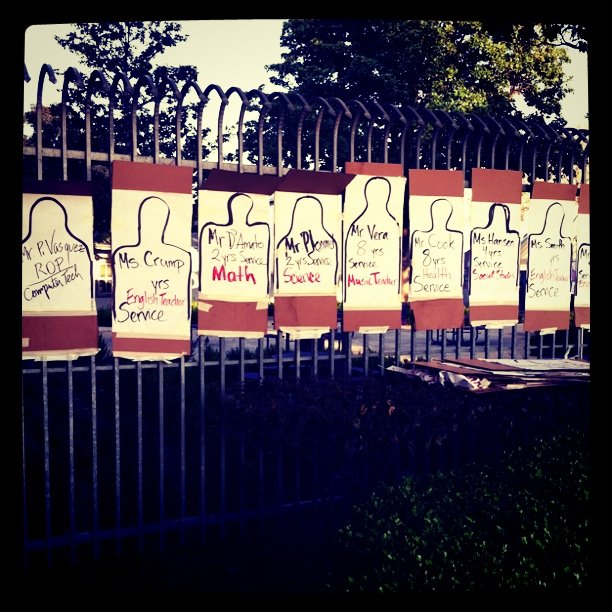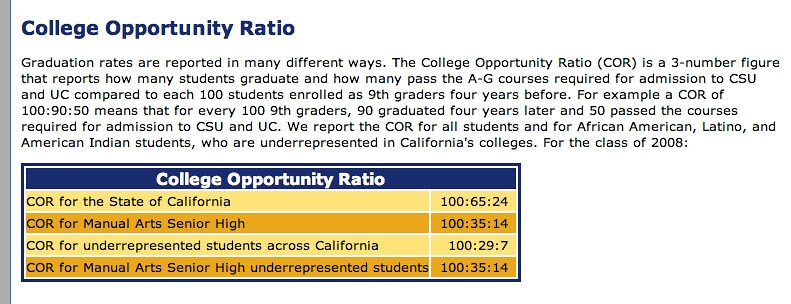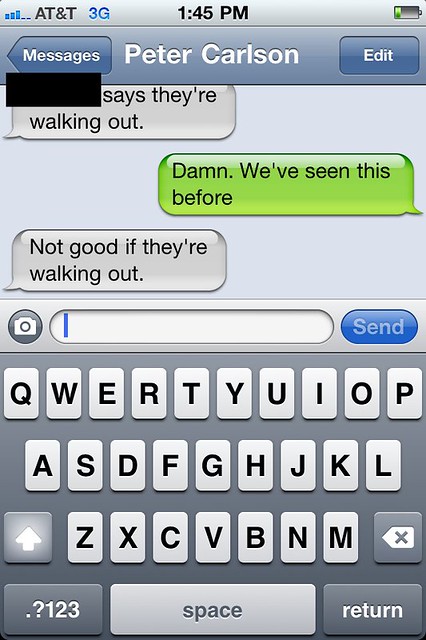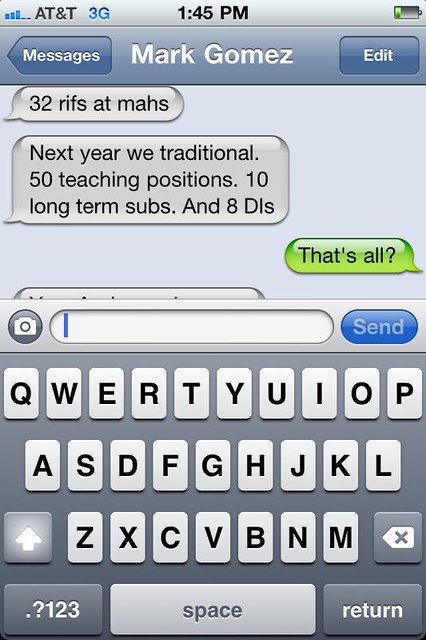
This is going to sound overly pessimistic and cynical, but it’s hard to read an article like this and not grit my teeth.
The anecdotal stories of layoffs are a useful tactic to maybe get the public to understand that there are faces and names to the teachers that are continuing to be cut and villainized in the current political rhetoric.
However, the article points to the inequity of cuts and to the general (more than usual) messy situation of layoffs in LAUSD. Hamilton students are in tears and parents are shocked by the loss of teachers they loved. This is something new for these students.
At Manual Arts, I want to applaud the continuing efforts of students to fight for teachers they are losing. But the picture is muddy and isn’t getting clearer any faster.
Here’s what would have been different if Steve Lopez had written about Manual Arts:
- there wouldn’t have been a sense of surprise: amazing teachers–like my friend Peter Carlson–have received layoff or Reduction in Force (RIF) notices every single year. It’s not even a surprise.
- students have been trying to be proactive in fighting for their education for a long time: Student walkouts became a persistent aspect of how students tried to fight for their teachers and for their education. These were both effective and detracting; some students felt like they were able to engage in public discourse that directly affected them; some students were able to miss a whole lot of class.
And before reading further, you might want to compare the general data–particularly the College Opportunity Ratio (COR)–for Hamilton and Manual Arts to see how these RIFs will play out.


Both images come from the UCLA IDEA’s California Educational Opportunity Report.
A Timeline for Dummies
Manual Arts is also a great microcosm of the mess in the district. If you want to know what the plight of public education looks like, here’s my best play-by-play of how it’s played out in … oh six months at my school:
November: Our sixth principal in the six years I’ve been here quits. [This is a highly politicized event that divides the campus. To leave things simple: I felt that Principal Irving was an effective leader in his professional role and I see his departure as a loss for our students. Not everyone will agree with me.]
December: Rumors of reconstitution and heavy RIF numbers are shared in weekly union meetings. It becomes clear that the QEIA grant funding that was paying for nearly 20 teachers and other faculty positions at the school is not being renewed next year. [This is a highly politicized event that divides the campus: some teachers blame our school’s network partner and leadership staff for the fact that we did not meet benchmarks that we set. Some teachers blame the school district for imposing benchmarks on us that we did not meet. In any case, these are real jobs that we had saved with these funds… because of these saved jobs, it looks like Manual Arts did not have a lot of RIFd teachers at our school, which directly impacts what happens as a result of … the Reed Settlement.]
January: The Reed Settlement is Approved. Anticipating the many layoffs that will likely occur under the current doomsday budget, 45 schools that would be impacted the most are placed on a list that would protect them. [This is a highly politicized event that divides union. To leave things simple: the settlement protects RIFd teachers at some schools but disrupts campuses that are not typically affected by these layoffs – schools in affluent in communities, schools that don’t have newer teachers, school that are probably doing academically better … probably schools like Hamilton High School.
[Oh yeah, despite being either the lowest or second lowest performing school in the district (depending on if you count Jordan’s missing API data from last year) … Manual Arts was NOT on the list of protected schools. Our administrative team was efficient enough in the past with shielding our staff from layoffs that we did not look like a school that will need to be protected. Instead the RIFs from other schools will burden our school on top of the RIFs we will already have. This will be very bad as we shall see.]
February: District RIF projections are around 5,000 teachers, we are told our school will move to a traditional calendar, Manual Arts is requested to create a plan to show the superintendent why we should not be reconstituted–all staff reapply for positions. [This is a highly politicized event that divides the campus. Several teachers–myself included–are seen as colluding with our network partner and are not seen as trustworthy.]
March 8: One of our network partners, WestEd, announces that they will not be involved with our campus in the near future. [This is a highly politicized event that divides our campus. Blame is placed on our other network partner.]
March 11: At an afterschool faculty meeting, our teachers are told that we will have 32 RIF teachers. In addition, (and partly because we are going to a traditional calendar) we are losing 50 other teachers, 10 long-term sub positions, and 8 district intern teachers. Yes, we are losing 100 out of 190 teachers. Oh yeah, and our expected enrollment next year is anticipated to be the same.
March 15: 32 Manual Arts teachers receive certified mail letters that let them know they are being laid off next year; they are neither surprised nor clear about what this means in terms of what will actually happen (RIFs are projected and some are rescinded in the past). Steve Lopez writes about the shock at Hamilton High School.
March 18: Students begin demonstrating at Manual Arts. Reports of walkouts and sit-ins trickle into texts and facebook updates throughout the day. [Update: brief coverage of student efforts here.]
Without adding too much more commentary, I want to point out how the snowball has been rolling into an avalanche throughout the year. Morale, unsurprisingly, is at an all time low at our school; we are still a big question mark in terms of our future. It could be minutes or days until we know about if our school is reconstituted. A mass exodus of teachers–those RIFd and those that have just had enough–is expected at the end of the year. I also want to point out how all of these events are layered in meaning. With each major announcement, the school roils in finger pointing. Calls for unity are voiced; a union election is wedged throughout all of this, as are the Public School Choice results, as is an election that affects the School Board, as is a new incoming Superintendent next month, as is an ongoing attack on unions and public education. The results compound rhetoric and confusion. At the end of the day, how will any of this help the 3400 students that will be walking into our classrooms at Manual Arts next year. Or tomorrow?


Mr Garcia, thank you. Thank you for showing that the issue of public education is not as black and white as most of society thinks. Thank you for giving the teaching profession a bit of good PR–again something that the general public gets very little of. And, finally, thank you for giving light to the inaccurate portrayal that teachers only work six hours a day, teach only because they couldn’t make it in the “real” world, and are in it solely for the easy money. Thank you!
OMG – I didnt know Duncan is at Fremont and we should’ve organized something.
And I just learned about yer blog here…. stuff re: Hami and inequities is interesting, and I can add another difference Steve Lopez would add to his column if he was writing about MAHS:
3. While admin at Hami allowed student leaders a podium at their organized protest on campus (check it out @:
, our interim principal and the on-site leadership of MLA responded by: taking photos of teachers who were deemed by admin as “participating and encouraging” students, wrote up a magnet teacher for what was deemed “inciting violence” by “escorting” kids to their protest, allowed ridiculous threats of “radiation clouds” to be used to threaten people back into class, and sent an email threatening teachers that we will be documented for jeopardizing safety and compromising instructional time if we are directly or indirectly (whatever that means) involved with student protests.
I think we ought to “politicize” THEIR actions- they want this to be divisive but we can and should unite and that’s what I’m feeling!!
Hope to see you this Saturday at the big rally. MAHS contingent is meeting at 10 at corner of Pico & Fig!! Bring your family, your parents and students, and your friends!
Very informative, Andy. Thank you.
So many times we say or hear others say that students, especially those in South Los Angeles, are resilient. We need to stop expecting/hoping students will be resilient and fight this on-going calamity.
We should believe in our right to protest and the students’ right. We should also act upon it. We should fight for students to get the education they deserve. We should fight for teachers to be treated like the hard working professionals that they are. We all, including students, need to stop letting state officials and district officials walk all over us. By not fighting back, we are conceding to the idea that their education and our profession do not matter.
These students are not brats, slackers, or hoodlums as some people would like to deem them as, especially when walking out or engaging in a sit-in. They are doing what too many teachers and citizens are afraid to do, which is shake up the system by fighting back. These acts are commendable, especially when it’s seniors fighting for younger students depsite the fact that their senior priviledges are threatened, as well as their position in sports. How horrible that admin would stoop so low and use fear tactics to control our students! How awesome that our students see things like going to Magic Mountain as trivial and will still fight!
Let’s take a lesson from these students, let’s look at the facts, let’s educate others, and let’s fight back!
indeed. well-done, mr garcia! i heard it said this morning and i agreed, to read your timeline alone causes shock. it is to see all that we’d been through in such a short amount of time – spelled out so simply here – so tragically. it’s a disgrace. i’m quite sure that this is what being a refugee must feel like. a ‘war’ victim. toxicity is what we shield these days from our kids. where do we put it? thanks garcia, again, for helping people see us/ know us. and kudos to you for the amazing things you and carlson do with the kids! superb examples you are for all educators. our kids are lucky to know you guys.
It is difficult not to be (or sound) cynical when one’s work, as a teacher is highly overlooked (as it is politicized). I taught for LAUSD (not far from Manual Arts HS) and other school districts and they all have a common denominator: RIFs and political rhetoric. In fact, I believe RIFs are seasonal. They are as common as subject area adoptions. The question is why is this such a cycle? I add, why have we yet to find a solution?
It’s admirable to see that you speak for many teachers, and empower your students. May your passion for education be contagious.
Pingback: The American Crawl : Once Again, Late to the Party
Pingback: The American Crawl : Transitions: Manual Arts, The Department of Education, and Stepping into the Productivity of the Summer
Pingback: The American Crawl : Teacher Facebook Groups & Civic Lessons: Learning from “The Truth About L.A.’s Promise”
Pingback: The American Crawl : A Series of Unfortunate Events (at Manual Arts)